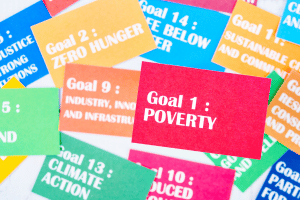Achieving the Sustainable Development Goals (SDGs) requires significant financial resources to address complex challenges such as poverty eradication, climate change mitigation, and gender equality. While the goals present a compelling vision for a more sustainable and equitable world, financing them poses numerous challenges. This article examines the financial aspects of achieving the SDGs, including investment needs, funding sources, and innovative financing mechanisms.
Investment Needs for SDGs:
The SDG financing gap is substantial, estimated to be trillions of dollars annually. Achieving the goals requires investments in various sectors, including infrastructure, healthcare, education, clean energy, and sustainable agriculture. Addressing cross-cutting issues such as climate change, gender equality, and social inclusion necessitates targeted investments and coordinated action across multiple stakeholders.
Funding Sources for SDGs:
Diverse funding sources are needed to finance the SDGs, including public, private, and blended finance. Public finance, including domestic budgets, official development assistance (ODA), and multilateral development assistance, remains a critical funding source for many developing countries. However, more than public resources are needed to meet the financing needs of the SDGs, necessitating a more significant mobilization of private capital.
Private finance, including foreign direct investment (FDI), philanthropic funding, impact investing, and corporate social responsibility (CSR) initiatives, is crucial in financing sustainable development. Private sector engagement can unlock innovative solutions, technology transfer, and market-driven approaches to address development challenges while generating financial returns for investors.
Blended finance, which combines public and private capital to finance projects with social and environmental objectives, has emerged as a promising approach to mobilize additional SDG resources. Blended finance mechanisms, such as guarantees, concessional finance, and risk-sharing instruments, help de-risk investments and attract private sector participation in sectors where returns may be uncertain or long-term.
Challenges in Financing SDGs:
Despite the growing recognition of the importance of financing the SDGs, several challenges hinder progress in mobilizing and allocating resources effectively:
- Investment Barriers: Structural barriers such as policy uncertainty, regulatory constraints, and market failures impede investment flows to SDG-related sectors, particularly in low-income and fragile states. Addressing these barriers requires coordinated action by governments, international organizations, and the private sector to create an enabling environment for sustainable investment.
- Fiscal Pressures: Many countries face budgetary pressures exacerbated by the COVID-19 pandemic, which limits their ability to allocate resources to SDG priorities. Rising debt levels, budget deficits, and competing demands for public spending pose challenges for financing essential services and infrastructure investments needed to achieve the goals.
- Inequality and Vulnerability: Persistent inequalities within and among countries, including income disparities, gender gaps, and spatial inequalities, exacerbate vulnerability and limit access to opportunities for marginalized and vulnerable populations. Financing the SDGs requires targeted interventions to address these inequalities and ensure no one is left behind in pursuing sustainable development.
Opportunities for Innovative Financing:
Despite the challenges, innovative financing mechanisms offer opportunities to unlock new sources of funding and leverage resources for the SDGs:
- Impact Investing: Impact investors seek to generate positive social and environmental impacts alongside financial returns. Impact investing can drive sustainable development and bridge financing gaps in underserved markets by channeling capital toward businesses and projects with measurable social and environmental outcomes.
- Green Finance: Green finance mobilizes capital for climate-related projects and investments that promote environmental sustainability. Instruments such as green bonds, loans, and carbon markets enable investors to support renewable energy, energy efficiency, and climate adaptation initiatives while generating financial returns.
- Social Impact Bonds: Social impact bonds (SIBs) are innovative financing instruments that leverage private sector capital to finance social programs with potential positive outcomes. Investors provide upfront funding for social interventions, and governments repay the investment based on achieving predetermined outcomes, incentivizing efficiency and effectiveness in service delivery.
- Digital Finance: Digital finance technologies, including mobile money, digital payments, and blockchain-based platforms, offer opportunities to expand access to financial services and mobilize resources for the SDGs. Digital finance can enhance financial inclusion, reduce transaction costs, and facilitate peer-to-peer lending and crowdfunding for sustainable development projects.
Financing the SDGs requires a multi-faceted approach that mobilizes resources from diverse sources, aligns investments with sustainable development priorities, and addresses structural barriers to financing. By leveraging innovative financing mechanisms, engaging public and private sector stakeholders, and promoting collaboration and coordination, the global community can unlock the financial resources needed to achieve the SDGs and build a more sustainable and prosperous future for all.



